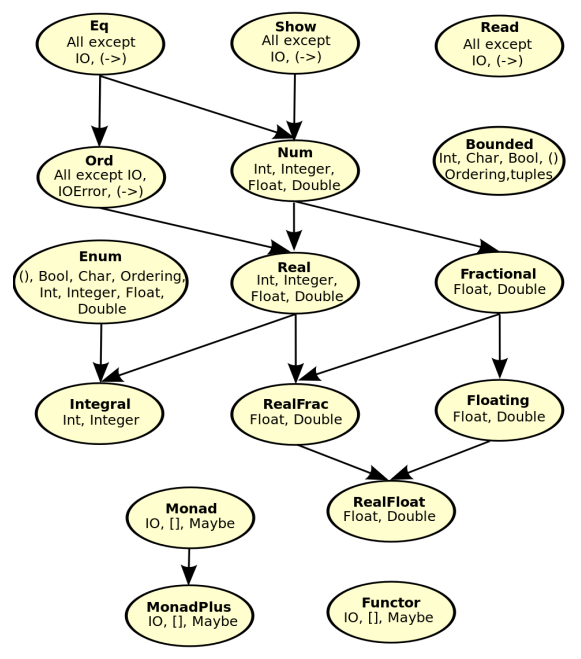Advanced-Programming
Haskell
Slides:
Data types
data Color = Red | Yellow | Blue
data Tree = Leaf Int | Node (Int, Tree, Tree)
Case expressions
case t of
Leaf n -> ...
Node(n, lt, rt) -> ...
Function types
f :: A -> B means for every x ∈ A, if f(x) terminates, then f(x) ∈ B.
Higher order functions
Any curried function with more than one argument is higher-order: applied to one argument it returns a function.
From functional to stream-like
length(tail(reverse [1,2,3])) => 2
becomes
[1,2,3] |> reverse |> tail |> length => 2
Map
Applies argument function to each element in a collection.
map (+1) [1,2,3] => [2,3,4]
Filter
Takes a collection and a boolean predicate, and returns the collection of the elements satisfying the predicate.
filter even [1..10] => [2,4,6,8,10]
Reduce
foldl, foldr, foldl', foldl1 etc.
sum' xs = foldl (\acc x -> acc + x) 0 xs
The difference between foldl and foldr is that the first start from the top, so is applicable also to infinite lists, the second one requires a finite list.
The difference between foldl and foldl' is that the second one uses tail-recursion (see below) and for that reason is more performant.
Recursion
Iteration and recursion are equally powerful in theoretical sense. Anyway, in general a procedure call is much more expensive than a conditional branch, thus recursion is in general less efficient.
Tail recursive functions
Non tail-recursive
int rfun() {
...
return 1+rfun();
}
Tail recursive
int trfun() {
...
return trfun();
}
Example
Quadratic, non tail recursive
reverse [] = []
reverse (x:xs) = (reverse xs) ++ [x]
Can be rewritten with tail-recursion in linear time
reverse xs =
let rev ([], accum) = accum
rev (y:ys, accum) = rev (ys, y:accum)
in rev (xs, [])
Type classes
Provide concise types to describe overloaded functions.
Allow users to define functions using overloaded operations and to declare new collections of overloaded functions.
A type class declaration defines a set of operations and gives the set a name.
Example: Eq a type class defines the operations == and \= with type a -> a -> Bool.
Usage: member:: Eq w => w -> [w] -> Bool.
Default type classes
Eq: equalityOrd: comparisonNum: numerical operationsShow: convert to stringRead: convert from stringEnum: operations on sequentially ordered types

Declaration
The class declaration says what the Num operations are.
class Num a where
(+) :: a -> a -> a
(*) :: a -> a -> a
negate :: a -> a
...
Instance
An instance declaration for a type Int says how the Num operations are implemented on Int’s.
instance Num Int where
a + b = intPlus a b
a * b = intTimes a b
negate a = intNeg a
...
Default methods
Type classes can define default methods. Instance declaration can still override it by providing a more specific definition. If an instance declaration doesn’t provide a method implementation, the default one is applied.
class Eq a where
(==) :: a -> a -> Bool
x == y = not (x /= y)
(/=) :: a -> a -> Bool
x /= y = not (x == y)
If is not necessary to override the default definition, deriving can be used.
Deriving
For Read, Show, Bounded, Enum, Eq and Ord the compiler can generate instance declaration automatically.
data Color = Red | Green | Blue
deriving (Show, Read, Eq, Ord)
Under the hood
This
square :: Num n => n -> n
square x = x * x
is compiled into this
square :: Num n -> n -> n
square d x = (*) d x x
where the extra value argument d of the function is a value of data type Num n and represents a dictionary of the required operations.
Furthermore, the compiler converts each type class declaration into a dictionary type declaration and a set of selector functions. In other words, this
instance Num Int where
a + b = intPlus a b
a * b = intTimes a b
negate a = intNeg a
...
is compiled into this
dNumInt :: Num Int
dNumInt = MkNum intPlus
intTimes
intNeg
...
Compositionally
sumSq :: Num n => n -> n -> n
sumSq x y = square x + square y
becomes
sumSq :: Num n -> n -> n -> n
sumSq d x y = (+) d (square d x) (square d y)
Functor
A type class where the predicate is over a type constructors rather than on a type.
Example:
instance Functor Tree where
fmap f (Leaf x) = Leaf (f x)
fmap f (Node(t1,t2)) = Node(fmap f t1, fmap f t2)
Monads
Constructor classes (type constructor) introducing operations for “putting a value into a box” (return) and compose functions that return “boxed” values (bind: x >>= y).
(>>=) :: Maybe a -> (a -> Maybe b) -> Maybe b
Functors with fmap allow to apply functions inside “boxes”.
Haskell monads
- Maybe
- Error
- State
- IO
- lists (
[]) - Reader
- Writer
Maybe
data Maybe a = Nothing | Just a
A value of type Maybe a is a possibly undefined value of type a.
A function f :: a -> Maybe b is a partial function from a to b.
Main
main::[Response] -> [Request]
IO
IO is a type constructor, instance of Monad. A value of type IO t is a computation or “action” that, when performed, may do some input/output before delivering a result of type t.
returnreturns the value without making I/O- Then (
>>) and bind (>>=) composes two actions sequentially into a larger action.
(>>=) :: IO a -> (a -> IO b) -> IO b

Binds the result of the left-hand action in the action on the right.
Evaluating an action has no effect, performing the action has the effect.
The only way to perform an action is to call it at some point, directly or indirectly, from Main.main.